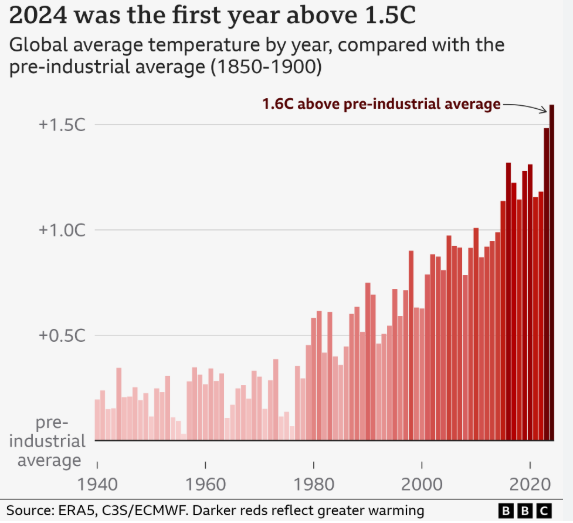2024 was the first year to breach global warming limit, show data
(Source – The Hindu, International Edition – Page No. – 5)
| Topic: GS3 – Environment |
| Context |
| ● In 2024, global temperatures surpassed 1.5°C above pre-industrial levels, signaling a climate crisis, with urgent calls for emissions reductions and financial support for vulnerable nations. |

Humanity’s Shift Towards Climate Crisis
- 2024 marked the first year when the global mean temperature exceeded 1.5°C above pre-industrial levels, as reported by the Copernicus Climate Change Service (C3S).
- This is a significant milestone in global warming, aligning with concerns raised at global climate conferences where leaders aim to limit warming to below 2°C, ideally staying under 1.5°C.
Annual Climate Conference Goals
- The primary objective of annual climate conferences is to establish global agreements to reduce carbon emissions and slow temperature increases.
- The ultimate goal is to prevent global temperatures from exceeding 2°C above pre-industrial levels, with the ideal target of limiting the rise to below 1.5°C to mitigate the most severe climate impacts.
Temperature Thresholds and Significance of 2024
- While surpassing the 1.5°C threshold in a single year does not signal an immediate climate catastrophe, experts warn that continued warming over a decade or more could result in permanent changes.
- The year 2024 is seen as a critical turning point. With rising carbon emissions, experts predict that global temperatures may surpass the 2°C mark by 2050, leading to devastating consequences.
| Record-Breaking Global Temperatures in 2024 |
| ● 2024 has been recorded as the warmest year in history, with the global average temperature reaching 15.1°C, 0.72°C above the 1991–2020 average and 1.6°C above pre-industrial levels (1850–1900).
● The past decade (2015–2024) saw each year among the ten warmest on record, signaling a worrying trend. ● The global temperature in 2024 consistently stayed above 1.5°C for 11 months, highlighting a worrying trajectory. Sea Surface Temperature and El Niño ● The average sea surface temperature (SST) in 2024 reached a record high of 20.87°C, 0.51°C above the 1991–2020 average. ● The period from January to June 2024 saw SSTs at record levels, while July to December followed closely as the second warmest on record, largely due to the ongoing El Niño event that started in June 2023. |
Implications of Record Temperatures
- Exceeding 1.5°C in 2024 signifies the world is perilously close to irreversible climate impacts.
- While a single year above this threshold is not conclusive, it underscores the urgency for swift and meaningful emissions reductions to avoid exacerbating the harm to ecosystems and human populations.
Concerns Over Financial Support and Climate Disasters
- The rising temperatures have serious consequences for developing economies, which are already grappling with frequent climate disasters.
- The failure of climate talks in Baku, Azerbaijan, to agree on a financial package for carbon emission mitigation worsens concerns, as developing countries now face more financial strain in addressing climate impacts.
- This failure delays action on carbon markets, threatening to undermine efforts for sustainable development in these vulnerable regions.
</table
| PYQ: Discuss global warming and mention its effects on the global climate. Explain the control measures to bring down the level of greenhouse gases which cause global warming, in the light of the Kyoto Protocol, 1997. (250 Words /15 marks)(UPSC CSE (M) GS-3 2022) |
| Practice Question: Evaluate the implications of surpassing the 1.5°C global temperature threshold in 2024 and its impact on global climate goals and vulnerable economies. (250 Words /15 marks) |
For more such UPSC related Current Affairs, Check Out –Decoding India’s growth slowdown

